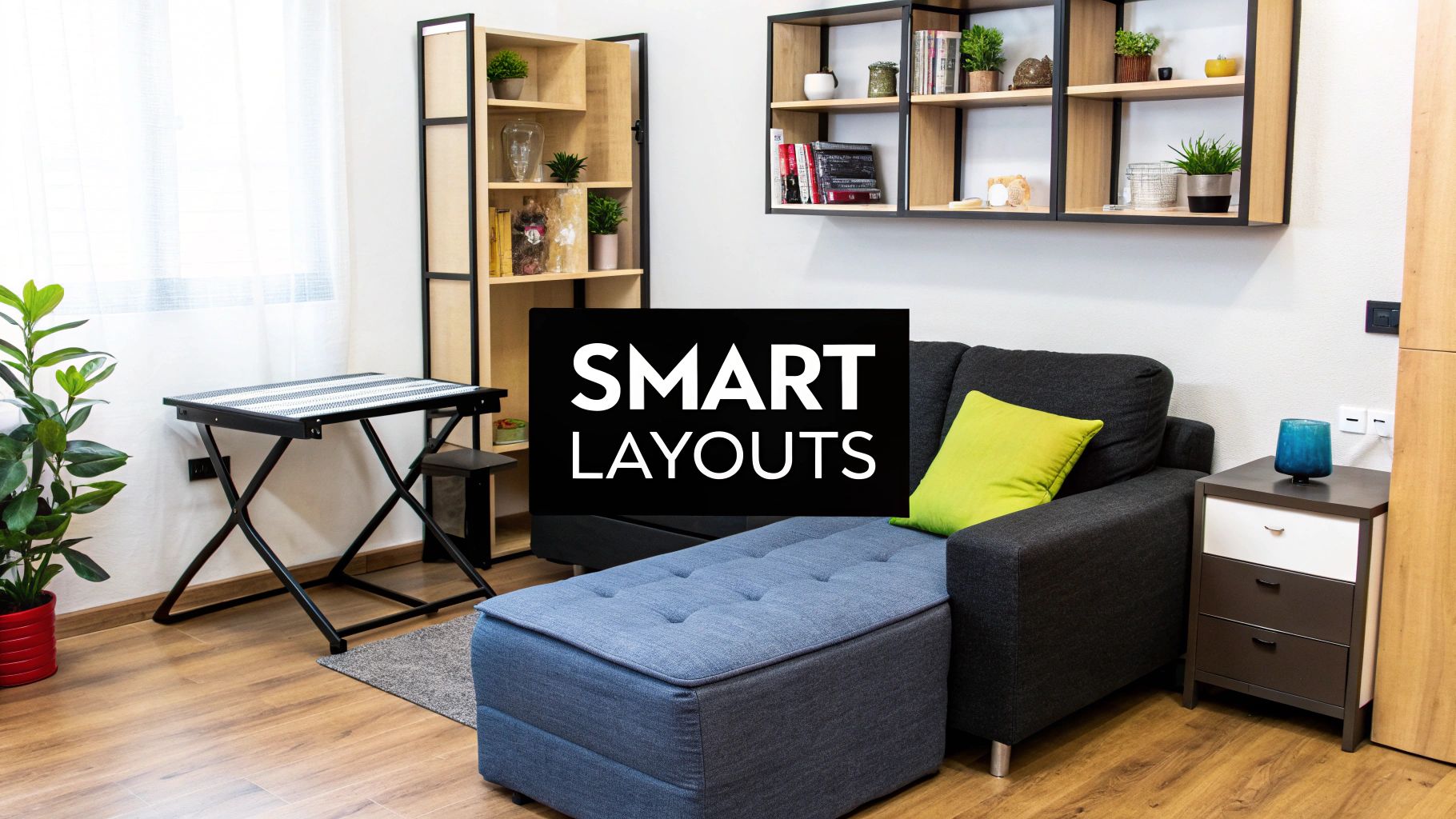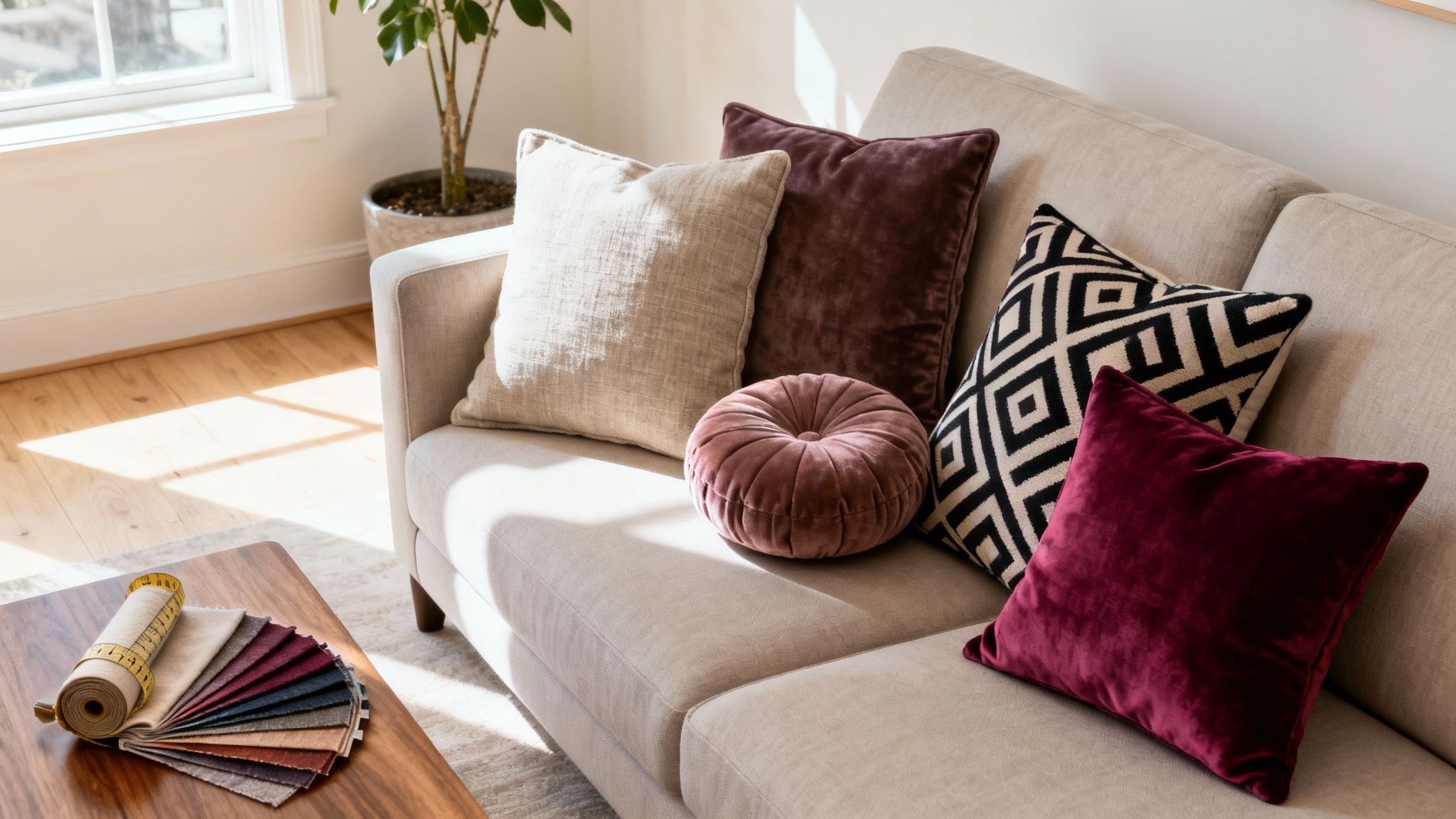Feeling boxed in by a small living room? You're not alone. Many UK homes feature cosy, compact living areas that can feel challenging to furnish and organise. But a small footprint doesn't have to mean sacrificing style or function. The secret to unlocking your room's potential lies in a clever layout.
Forget pushing furniture against the walls and hoping for the best. With the right strategy, you can create a space that feels open, inviting, and perfectly suited to your lifestyle. This guide moves beyond generic advice to explore distinct and actionable small living room layout ideas, each designed to help you maximise every square inch of your home. We will provide practical examples, specific furniture arrangements, and fresh perspectives that will inspire you to see your compact space in a new, expansive light.
Whether you're decorating a studio flat in the city or a snug terrace house in the country, these layouts offer the blueprint for a beautiful and highly functional living area. Get ready to rethink what's possible and transform your compact room into a stylish, comfortable, and well-organised haven you'll love spending time in.
1. The Floating Furniture Layout: Create Flow and Breathing Room
It might seem counterintuitive, but one of the most effective small living room layout ideas involves pulling your furniture away from the walls. This approach, known as the floating layout, challenges the common impulse to push everything to the perimeter. Instead, key pieces like your sofa, armchairs, and coffee table are grouped together in the centre of the room, creating an 'island' that encourages conversation and improves traffic flow.
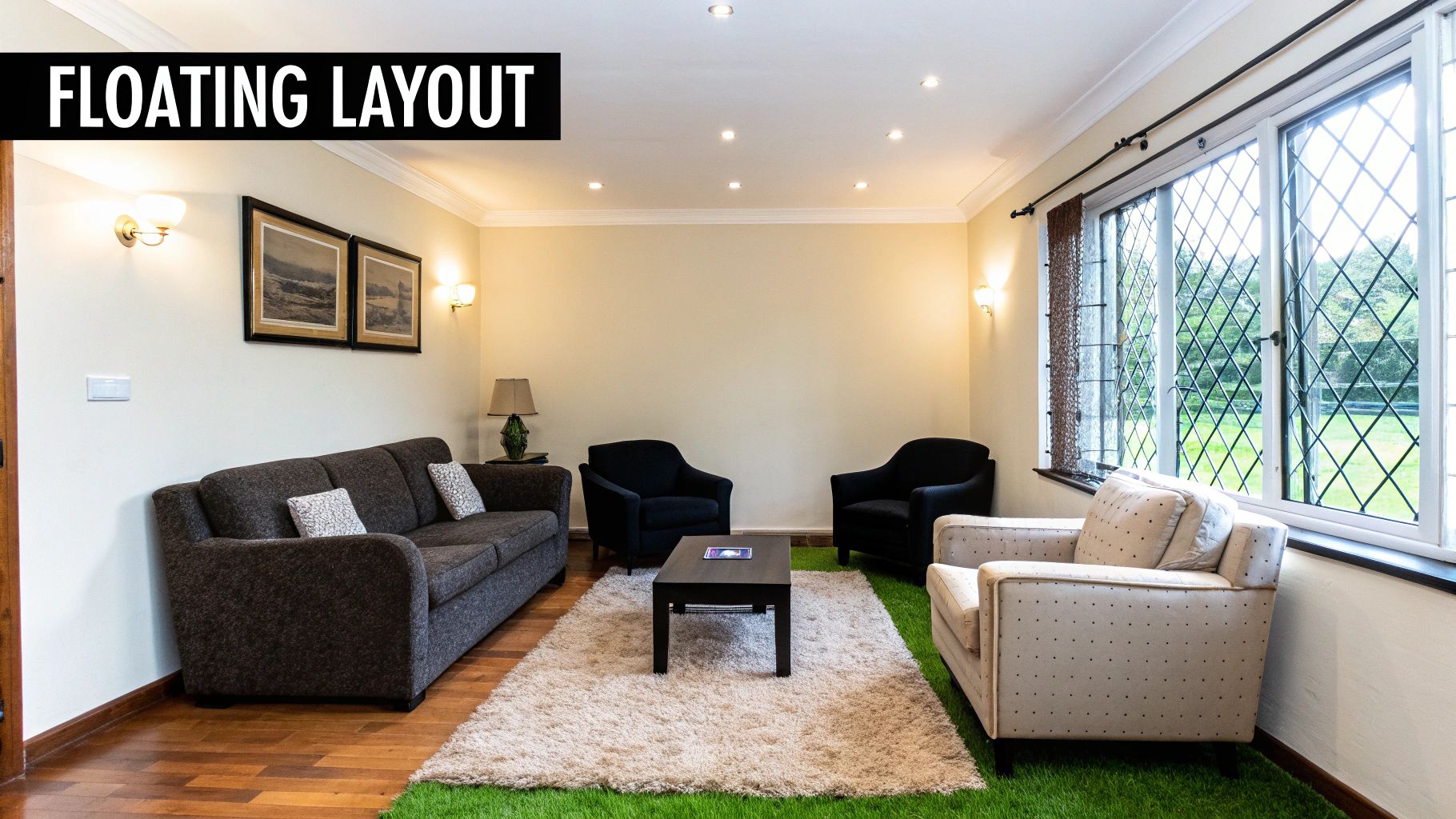
The primary benefit is the illusion of space. By creating clear pathways around your furniture grouping, you allow the room to breathe. Your walls are no longer just boundaries for your furniture; they become part of the decor, making the entire area feel more open, airy, and intentional. This technique is championed by designers like Nate Berkus and Emily Henderson for its ability to transform a cramped room into a sophisticated, well-defined living space.
How to Implement a Floating Layout
This layout is particularly effective in open-plan homes or studio flats, where it can act as a soft divider. For instance, a floating sofa can neatly separate the living zone from a dining area or home office without needing a physical wall. In a narrow Victorian terrace, positioning a sofa slightly away from the wall allows for a slim console table behind it, creating a functional and subtle entryway feature.
Key Insight: The success of a floating layout hinges on an area rug. The rug acts as a visual anchor, unifying the furniture pieces and grounding them within the space. Ensure at least the front legs of your sofa and chairs are on the rug to create a cohesive look.
Actionable Tips for Success
To make this layout work, precision is key. Follow these guidelines to achieve a balanced and functional arrangement:
- Anchor Your Zone: Use a large area rug to define the living space and tie the floating elements together.
- Mind the Gaps: Aim for at least 45 cm (18 inches) between your sofa and coffee table for comfort, and ensure main walkways around the furniture are at least 75 cm (30 inches) wide.
- Choose Leggy Furniture: Pieces with visible legs, such as mid-century modern sofas or chairs, enhance the sense of openness by allowing you to see more of the floor.
- Build Around a Hero Piece: Start with your largest piece, typically the sofa, and arrange smaller items like armchairs and side tables around it to create an intimate setting.
2. L-Shaped Sectional Corner Layout: Maximise Seating and Cosiness
For those who need to maximise seating in a minimal footprint, the L-shaped sectional corner layout is a game-changing solution. This popular approach involves placing a sectional sofa snugly into a corner, using otherwise awkward space to create an expansive and inviting seating hub. This frees up the centre of the room, making the entire area feel larger and more organised.
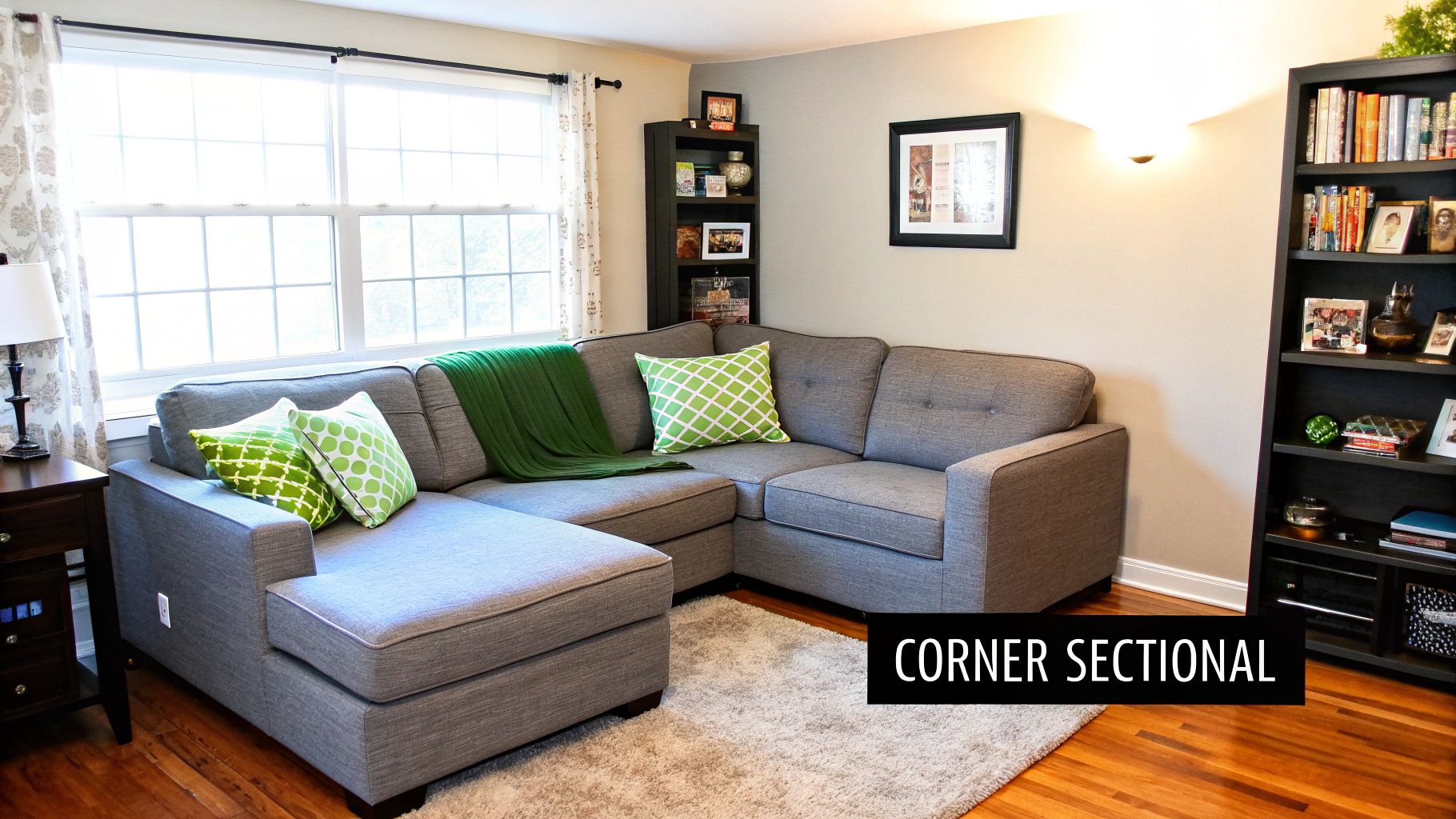
The main advantage is its efficiency. Unlike a traditional sofa-and-armchairs combo, a sectional provides continuous seating, which is perfect for families or entertaining guests. By anchoring the largest furniture piece in the corner, you establish a clear focal point and a cosy nook for relaxation. This strategy is championed by high-street retailers like IKEA and Ashley Furniture HomeStore for its practical, space-saving benefits in modern homes.
How to Implement a Sectional Corner Layout
This layout is incredibly versatile, working well in small apartments, basement family rooms, and studio flats. In a studio, for example, the "L" of the sofa can act as a natural divider, separating the living area from a bedroom or kitchen space without closing it off. For a small square or rectangular room, it consolidates seating into one zone, leaving ample floor space for a coffee table and clear traffic paths.
Key Insight: The scale of the sectional is crucial. A common mistake is choosing a sofa that is too large, which can overwhelm the room. Always measure your space carefully and consider a model with a chaise or a shorter return arm to ensure it fits comfortably without dominating.
Actionable Tips for Success
To get this layout right, focus on balance and proportion. These tips will help you create a functional and stylish corner arrangement:
- Measure Meticulously: Before buying, tape the sectional's dimensions onto your floor to visualise its footprint and ensure it won't block doorways or walkways.
- Choose Leggy Designs: Sectionals with exposed legs create visual space underneath, making the room feel lighter and more airy.
- Opt for Modularity: Consider a modular sectional. These flexible pieces can be reconfigured to suit different needs or moved more easily if you relocate.
- Select the Right Table: Pair your sectional with a round or oval coffee table to soften the straight lines and improve flow around the seating area.
3. The Multi-Functional Furniture Layout: Making Every Piece Work Harder
When floor space is at a premium, one of the most intelligent small living room layout ideas is to ensure every piece of furniture earns its keep. This layout prioritises multi-functional pieces that serve two or more purposes, such as an ottoman with hidden storage, nesting tables that can be expanded or tucked away, or a stylish sofa bed for overnight guests. The goal is to maximise utility without increasing the furniture footprint.
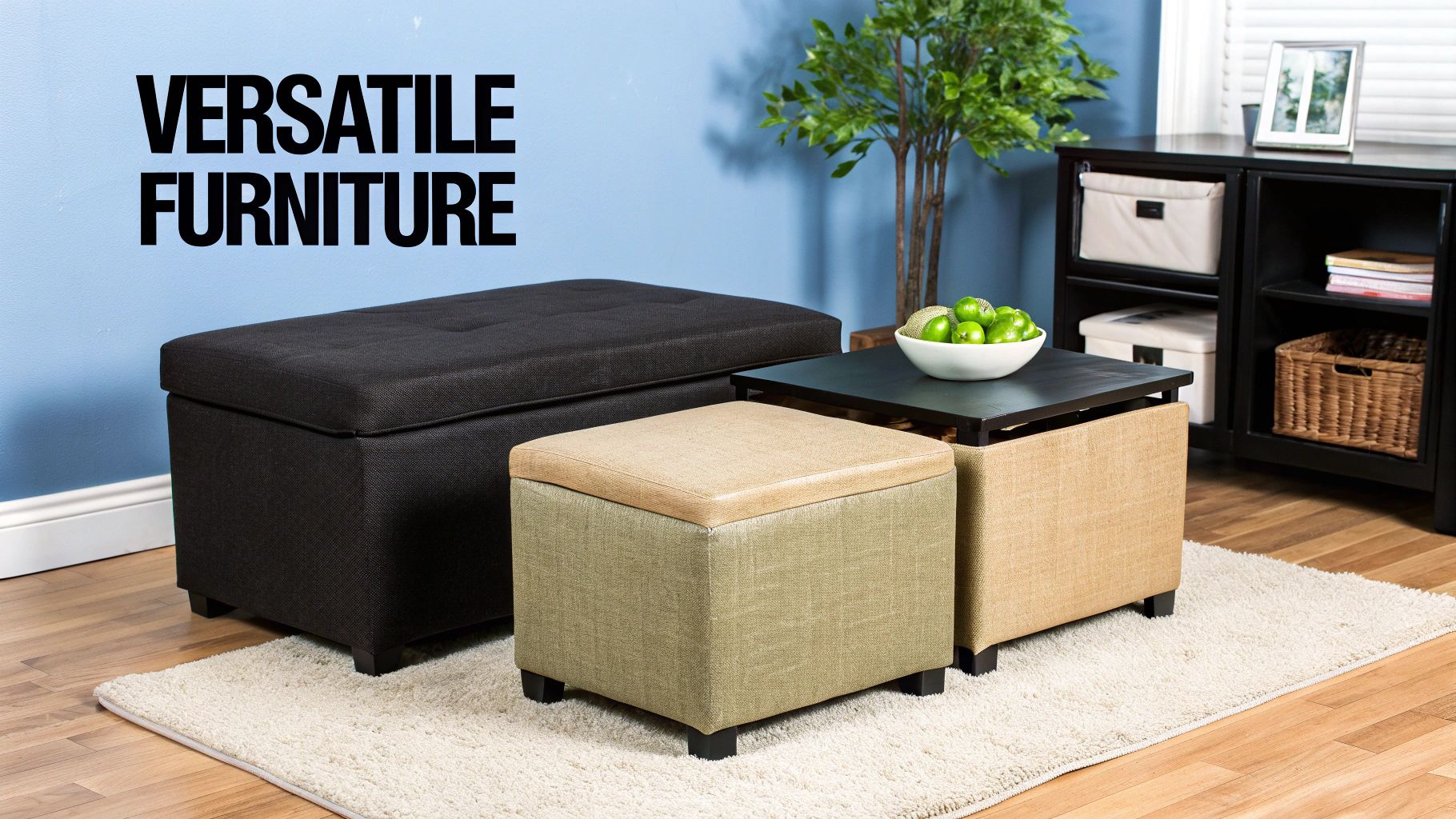
This approach transforms your living room into a dynamic and adaptable space. It moves beyond static decoration, creating an environment that can easily shift from a cosy lounge to a guest room, home office, or dining area. Brands like MUJI and CB2 have popularised this concept by championing minimalist designs that conceal clever, space-saving mechanisms. It’s the ultimate solution for making a small room feel both highly functional and uncluttered.
How to Implement a Multi-Functional Layout
This strategy is a lifesaver in studio apartments, where a single room must fulfil multiple roles. Imagine a layout where a fold-down desk integrated into a shelving unit serves as a workspace during the day, then disappears at night. In a small new-build flat, a lift-top coffee table can elevate to become a comfortable dining surface, while a storage ottoman can house blankets, board games, or remote controls, eliminating the need for extra cabinetry.
Key Insight: The secret to a successful multi-functional layout is to plan for transitions. Choose pieces with easy-to-use mechanisms and ensure you have clear space to convert them. A clunky sofa bed or an inaccessible storage ottoman will only add frustration, not function.
Actionable Tips for Success
To curate a truly versatile space, focus on clever design and practical application.
- Prioritise Your Needs: First, identify the primary and secondary functions your living room must serve. Choose furniture that addresses your most frequent activities.
- Invest in Quality Mechanisms: Before buying, test the conversion mechanisms on items like sofa beds or lift-top tables. They should be smooth, durable, and easy to operate.
- Embrace Nesting and Stacking: Nesting side tables or stackable stools offer flexible surfaces and seating that can be neatly stored away when not in use.
- Consider Mobility: Furniture on castors, like a small bar cart or storage unit, can be easily repositioned to adapt the room’s layout for different occasions.
4. The Vertical Emphasis Layout: Drawing the Eye Upwards
When floor space is at a premium, one of the most clever small living room layout ideas is to direct attention upwards. The Vertical Emphasis Layout utilises tall furniture, high-reaching decor, and floor-to-ceiling design elements to create an illusion of height and grandeur. By forcing the eye to travel vertically, you make the room feel more expansive and less confined by its modest footprint.
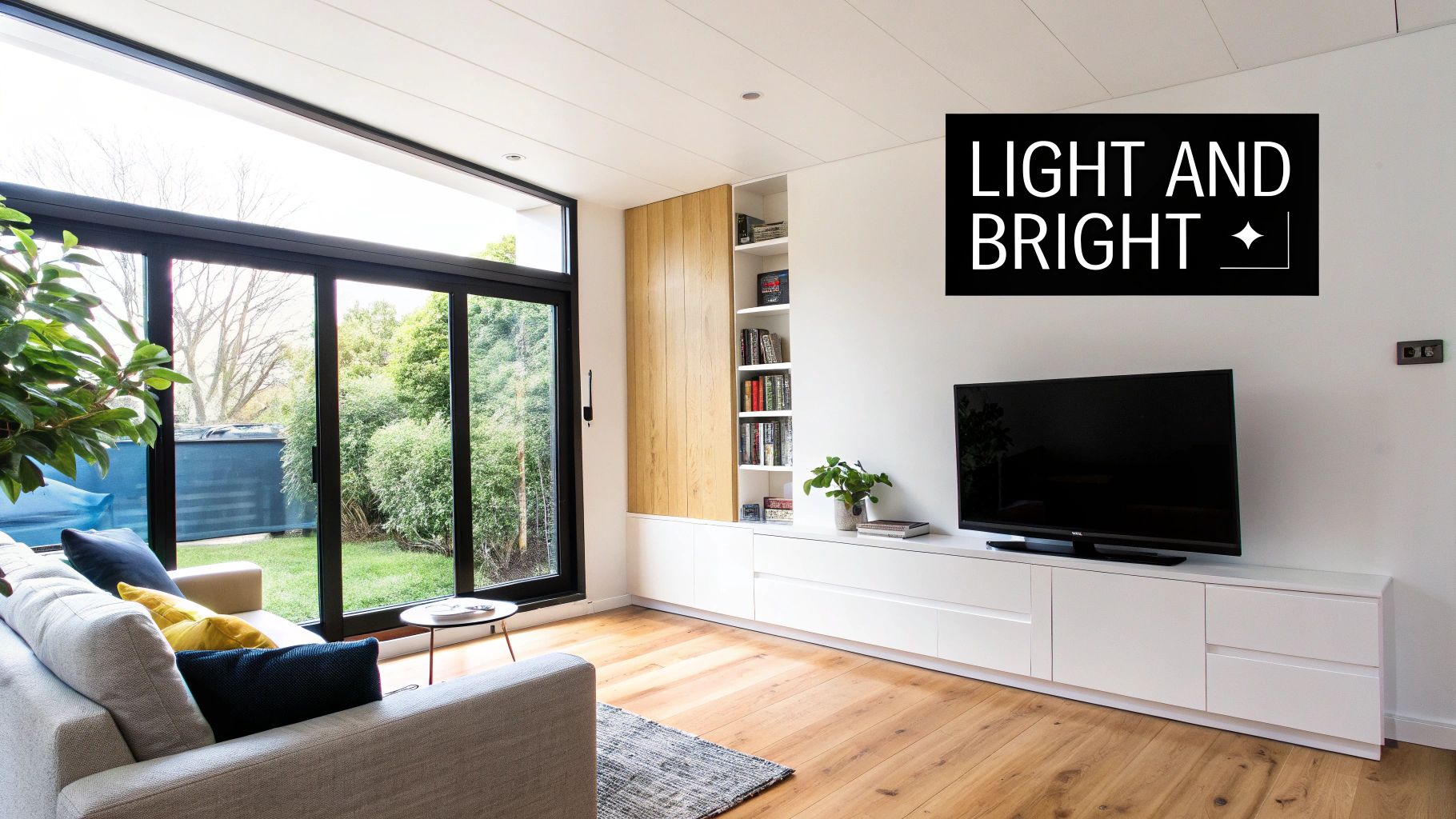
The core principle is maximising your wall real estate. Instead of focusing on horizontal spread, this layout capitalises on vertical lines to trick the brain into perceiving more volume. This strategy, often employed by storage solution experts like the Container Store design team and Joanna Gaines, transforms walls from simple dividers into functional, statement-making features, lifting the entire room's atmosphere.
How to Implement a Vertical Layout
This layout is a game-changer for rooms with high ceilings, but it's equally effective in standard-height spaces. In a small flat, floor-to-ceiling built-ins can provide immense storage without occupying much floor space, housing everything from books to electronics. For narrow living rooms, a vertical gallery wall featuring a collection of portraits or prints arranged in a column draws the eye up, making the walls feel taller.
Key Insight: The success of this layout depends on visual balance. While vertical elements are the stars, they must be grounded with lower-profile horizontal pieces, such as a sleek sofa or a low coffee table, to prevent the room from feeling top-heavy and disconnected.
Actionable Tips for Success
To master the vertical layout, focus on creating strong upward lines while maintaining a harmonious balance.
- Go Tall with Furniture: Choose tall, narrow bookcases, étagères, or cabinets. These pieces naturally draw the eye up and offer valuable storage.
- Hang Curtains High: Mount your curtain rod as close to the ceiling as possible and use long drapes that skim the floor. This simple trick instantly adds perceived height.
- Create a Vertical Gallery: Arrange artwork or photos in a vertical column rather than a horizontal line. This guides the gaze upward and makes a sophisticated statement.
- Embrace Vertical Stripes: Consider wallpaper with a subtle vertical stripe pattern on an accent wall to enhance the illusion of height.
- Use Up-Lighting: Place floor lamps or sconces that cast light upwards to highlight the ceiling and create a sense of openness.
5. The Open Floor Plan Zone Layout: Define Your Space Without Walls
For those with studio apartments, loft conversions, or open-plan homes, creating a cosy and organised living area can be a significant challenge. The Open Floor Plan Zone Layout is one of the most intelligent small living room layout ideas for this scenario. It involves using furniture, rugs, and lighting to create distinct functional zones without erecting physical walls, maintaining a bright and airy feel.
This method allows you to establish a dedicated living area, a dining space, and even a home office within a single room. Popularised by design shows and the Scandinavian design movement, this approach relies on visual cues rather than structural barriers. By thoughtfully arranging your belongings, you can guide movement and assign a clear purpose to each part of the room, making the entire space feel larger and more intentional.
How to Implement a Zone Layout
This layout is the go-to solution for maximising functionality in multi-purpose spaces. In a studio flat, you can use the back of a sofa to create a soft boundary between the living and sleeping areas. In a larger open-plan condo, a strategically placed console table or an open-backed bookshelf can delineate the lounge from the dining zone while still allowing light and conversation to flow freely.
Key Insight: The power of zoning lies in creating "rooms within a room." Use large area rugs to anchor each distinct zone, such as one for your living area and another for your dining set. This technique visually separates the functions while a consistent colour palette ties the whole space together cohesively.
Actionable Tips for Success
To master the art of zoning, focus on creating clear, yet subtle, divisions. Follow these tips to craft a harmonious open-plan environment:
- Anchor with Rugs: Define each functional area with its own distinct rug. This is the simplest and most effective way to create visual separation.
- Vary Your Lighting: Use different types of lighting for each zone. A statement pendant light can hang over the dining area, while softer table lamps create an intimate feel in the living space.
- Use Furniture as Dividers: Position larger pieces like sofas, shelving units, or screens to act as natural partitions that guide traffic flow.
- Maintain Sight Lines: Arrange furniture to preserve long, clear views across the room. This ensures the space continues to feel open and connected, even with defined zones.
6. The Light and Bright Minimalist Layout: Maximise Space Through Simplicity
The minimalist approach is one of the most powerful small living room layout ideas for creating an uncluttered and expansive feel. It champions the principle of 'less is more', focusing on clean lines, a limited colour palette, and only the most essential furniture. This layout declutters both physically and visually, allowing natural light to become a key decorative element that bounces around the room, making it feel larger and more serene.
The core benefit is the creation of a calm, airy atmosphere that combats the claustrophobic feeling common in smaller spaces. By carefully selecting fewer, high-quality pieces and keeping surfaces clear, the room breathes and feels intentionally designed rather than just filled. This aesthetic, heavily influenced by Scandinavian design and the Marie Kondo philosophy, proves that thoughtful curation is more impactful than sheer quantity.
How to Implement a Minimalist Layout
This layout is perfectly suited for modern minimalist condos, small beach houses with a natural aesthetic, or any home where maximising light is a priority. Imagine a Scandinavian-inspired apartment where a simple, light-grey sofa is paired with a single oak coffee table and a sculptural floor lamp. The walls are kept white, and windows are dressed with sheer, translucent curtains to diffuse sunlight beautifully throughout the space.
Key Insight: True minimalism isn't about stark emptiness; it's about intentionality. Each piece should serve a purpose or bring you joy. To prevent the space from feeling cold, introduce warmth through natural textures like a woollen throw, linen cushions, or a jute rug.
Actionable Tips for Success
Achieving a successful minimalist layout requires discipline and a keen eye for detail. Follow these guidelines to create a space that is both functional and beautifully simple:
- Maximise Natural Light: Use sheer or light-filtering window treatments instead of heavy curtains. Position a large mirror opposite a window to reflect light and the view.
- Embrace a Neutral Palette: Stick to whites, beiges, and soft greys for walls and large furniture pieces. This creates a cohesive and expansive backdrop.
- Choose Furniture Wisely: Select pieces with clean lines and a low profile. Multifunctional furniture, like a storage ottoman or a coffee table with drawers, is key to keeping clutter hidden.
- Add Warmth with Texture: Incorporate natural materials like wood, wool, linen, and rattan to add depth and prevent the space from feeling sterile. Potted plants are also excellent for adding a touch of organic colour and life.
7. The Gallery Wall Focus Layout: Maximise Personality, Minimise Footprint
When floor space is at a premium, one of the most impactful small living room layout ideas is to draw the eye upwards and create a dramatic focal point. The gallery wall focus layout achieves this by dedicating a significant portion of a wall to a curated collection of art, photographs, and objects, turning it into the room's main feature. This allows you to keep furniture arrangements minimal and streamlined, infusing the space with character without sacrificing valuable floor area.
The brilliance of this layout is its ability to create a sense of scale and depth. A large, well-composed gallery wall commands attention, making the room feel more significant and thoughtfully designed. Instead of cluttering surfaces with decorative items, your personality is displayed vertically, freeing up space for movement and function. This strategy is championed by design influencers like Emily Henderson and platforms such as The Everygirl for its power to transform a bland, small room into a vibrant, personalised sanctuary.
How to Implement a Gallery Wall Focus Layout
This approach is exceptionally effective in narrow living rooms or boxy new-build flats where architectural interest is lacking. A floor-to-ceiling gallery wall can become a powerful substitute for a feature fireplace or large window. For example, in a long, slender room, a horizontal gallery arrangement above a sofa can visually widen the space. In a small apartment, a mixed-media display incorporating mirrors, prints, and personal mementos can make the living area feel curated and uniquely yours.
Key Insight: The success of a gallery wall focus layout depends on balance. The furniture should complement, not compete with, the wall. Opt for a low-profile sofa, a simple coffee table, and neutral textiles to allow the gallery wall to remain the undisputed star of the show.
Actionable Tips for Success
A stunning gallery wall requires planning, not just hammering nails. Use these tips to create a cohesive and captivating display:
- Plan on the Floor First: Before making any holes, arrange your frames and objects on the floor. Use paper cutouts of each frame to test the layout on the wall itself.
- Mix It Up: Combine different frame sizes, styles, colours, and orientations for a dynamic, collected-over-time feel. Don't be afraid to mix high-end prints with family photos.
- Keep Spacing Consistent: Aim for a uniform gap of 5-8 cm (2-3 inches) between each piece to ensure the collection looks unified rather than chaotic.
- Add Dimension: Include three-dimensional items like small sculptural pieces, decorative plates, or even a small plant on a wall-mounted holder to add depth and interest.
- Use Picture Ledges: For ultimate flexibility, install a few picture ledges. This allows you to easily swap out art and objects without creating new holes, keeping your display fresh.
7 Small Living Room Layouts Comparison
Your Space, Reimagined
The journey through these distinct small living room layout ideas reveals a powerful truth: a compact space is not a limitation, but a canvas for ingenuity. From the visual lightness of the Floating Furniture Layout to the clever zoning of an Open Floor Plan, each strategy offers a unique solution to the challenges of limited square footage. We have moved beyond generic advice, providing you with a tactical playbook for transforming your home.
The core principle that unites all these approaches is intentionality. A successful small living room layout is never accidental. It is the result of a thoughtful assessment of your room's architecture, your daily routines, and your personal style. Whether you choose the cohesive comfort of an L-Shaped Sectional or the personality-driven Gallery Wall Focus, the goal is to make every centimetre count.
Key Takeaways for Your Layout Transformation
To truly master your space, remember these fundamental principles:
- Define Your Zones: Even in a tiny room, creating distinct areas for conversation, relaxation, or passage is crucial. This is the secret behind the Open Floor Plan Zone Layout and prevents the space from feeling like a single, cluttered entity.
- Embrace Multi-Functionality: As seen in the Multi-Functional Furniture Layout, pieces that work harder, like storage ottomans or expandable coffee tables, are your greatest allies. They reduce clutter and maximise utility without demanding more floor space.
- Think Vertically: Drawing the eye upward with tall shelving, strategic art placement, or floor-to-ceiling curtains, as highlighted in the Vertical Emphasis Layout, creates an illusion of height and airiness that can dramatically alter a room’s feel.
- Prioritise Light: Never underestimate the power of natural and artificial light. The Light and Bright Minimalist Layout is built on this concept, using mirrors, light colours, and sheer window treatments to make a space feel open and expansive.
Your Actionable Next Steps
Now, it is time to translate inspiration into action. Begin not by buying new furniture, but by experimenting. Choose one of the small living room layout ideas that resonates most with your needs and dedicate an afternoon to reconfiguring your existing pieces. Live with the new arrangement for a week. Notice how it impacts your movement, your comfort, and your mood.
This process of trial and error is the most valuable part of the design journey. It empowers you to create a home that is not just aesthetically pleasing but is a genuine reflection of how you live. A well-designed room should feel effortless, comfortable, and uniquely yours. By applying these strategic layouts, you are not just decorating; you are reclaiming your space and enhancing your quality of life, proving that thoughtful design, not size, is what truly makes a house a home.
Ready to find the perfect pieces to complete your new layout? Explore the curated collections and design-led editorials at Spruce Collective. We specialise in stylish, space-conscious furniture and décor to help you create a beautiful, functional home, no matter the size. Visit Spruce Collective today for inspiration and exclusive member rewards.
Article created using Outrank

